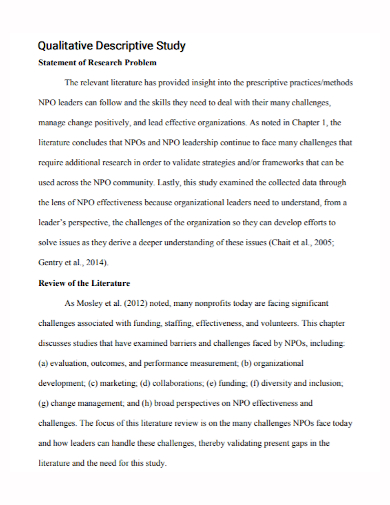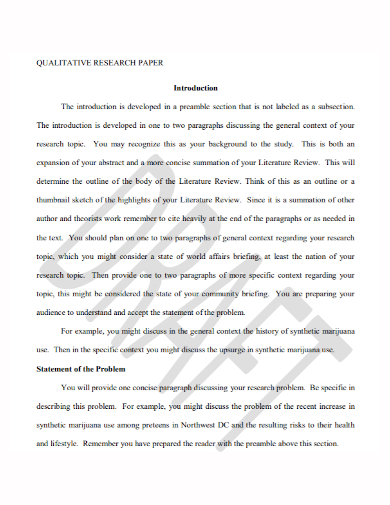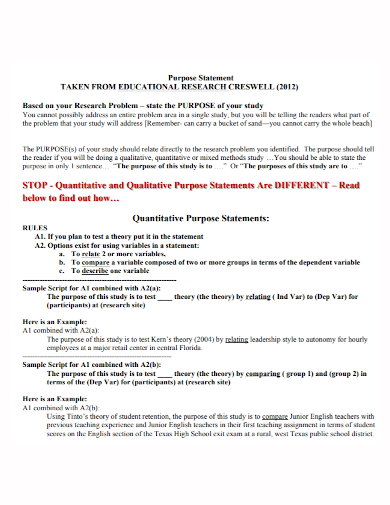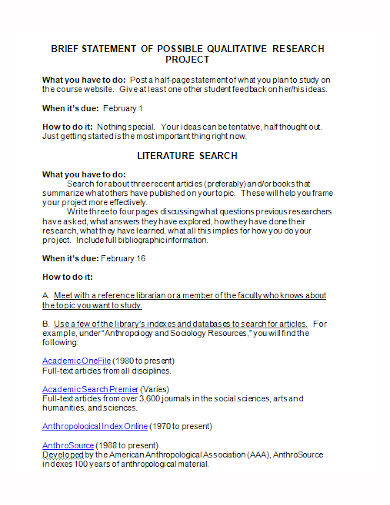As a humanistic or idealistic method, qualitative research focuses on understanding a study query. People’s views, experiences, attitudes, behavior, and interactions are studied using qualitative methods. People and organizations are thus researched in their natural environment. If you’re currently starting a research study, you would know that one of the processes in a qualitative paper is writing the research statement. For your convenience, we offer you free and ready-to-use samples of a Qualitative Research Statement that you could use to present your research’s purpose or problem. Keep on reading to find out more.
3+ Qualitative Research Statement Samples
1. Qualitative Descriptive Study Research Statement
2. Qualitative Research Paper Problem Statement
3. Qualitative Research Purpose Statement
4. Qualitative Project Research Statement
What Is a Qualitative Research Statement?
A distinct objective or intent will be presented in qualitative research purpose statements, and a specific idea will be investigated. You’ll also be able to see exactly how and where you’ll be learning. A solid qualitative purpose statement includes details on the study’s central phenomenon and participants. Rather of focusing on countable, numerical figures, the data is descriptive. A qualitative research statement explains what is being investigated or examined, how it is being investigated, and where it is being investigated. Essentially, a qualitative research purpose statements, which investigate a central phenomenon.
How to Make a Qualitative Research Statement
If you’re interested in making a qualitative research statement, you could use the free templates provided above to help you out. Other than that, here are the following statements you could use to write your statement from the ground up:
1. Identify the type of testing or inquiry approach you’ll employ to conduct your qualitative research.
Indicate if you intend to conduct an experiment or conduct a correlational study, which is the act of evaluating the extent of relationships between variables using statistical data. Explain whether you plan to conduct ethnographic research, which is a type of social science research that relies on personal experience and engagement rather than just observation.
2. Describe the goal of the qualitative research you’ll do.
Determine the variables you’ll be testing and evaluating, as well as the observable occurrences or phenomena you’ll be looking for. Predict which hypotheses you’ll test and which questions your study will raise. Describe the significance of your research and how it will add to previous research and understanding on your issue.
3. Give your qualitative study a name and a target population.
Describe how the researcher and participants will interact in your study, such as if they will be observed, interviewed, or asked to complete a questionnaire. Declare, for example, that your study is focused on a specific population or demography.
4. Extend the initial purpose of your qualitative study by describing your research’s additional objectives.
Describe any other variables that are relevant to these additional aims, as well as any qualitative phenomena you want to investigate. Reiterate the key concepts and ideas that you’ve learned thus far.
FAQs
What’s the difference between a qualitative research statement and a quantitative research statement?
Quantitative research is concerned with numbers and figures, whereas qualitative research is concerned with words and their interpretations. Quantitative approaches allow you to test a theory by gathering and analyzing data in a methodical way, whereas qualitative methods allow you to dig deeper into ideas and experiences.
What is the definition of a research purpose statement?
A purpose statement is a declarative statement that highlights the major goal or goals of a research study. A purpose statement acts as an introduction to the resulting article or dissertation chapter and provides some direction in selecting a research question.
In qualitative research, how are sources used?
Qualitative researchers collect data from a variety of sources in order to gain a better understanding of the subject they are researching. In-depth interviews, focus groups, standardized interviews, and artifacts such as books or works of art are among the data sources.
Why would you select qualitative research over quantitative research?
Qualitative research methods provide a dynamic approach to study, allowing the researcher to follow up on responses made by respondents in real-time, resulting in important dialogue around a topic.
Overall, a research statement is used to determine the substance of a research paper, the research’s primary themes, and the research’s future direction. To assist you with this, you may download our easily modifiable and printable samples of Qualitative Research Statements today!
Related Posts
FREE 10+ Marketing Problem Statement Samples [ Strategy, Digital, Social Media ]
FREE 10+ Medical Problem Statement Samples [ Surgical, Nursing, Management ]
FREE 10+ Payoff Statement Samples in PDF | DOC
FREE 10+ Scholarship Statement of Purpose Samples in PDF | DOC
FREE 10+ Engineering Problem Statement Samples [ Software, Mechanical, Civil ]
FREE 30+ Information Statement Samples in PDF | MS Word
FREE 50+ Policy Statement Samples in MS Word | Google Docs | PDF
FREE 50+ Summary Statement Samples in PDF | MS Word
FREE 10+ Nursing School Personal Statement in PDF
FREE 9+ Mortgage Statement Samples and Templates in PDF
FREE 10+ Independent Subcontractor Statement Samples in MS Word | Google Docs | Apple Pages | PDF
FREE 10+ Trust Distribution Statement Samples in PDF
FREE 14+ Compliance Statement Samples & Templates in PDF | MS Word
FREE 10+ Extension Impact Statement Samples in PDF | DOC
FREE 10+ Bank Reconciliation Statement Samples and Templates in PDF | MS Word




